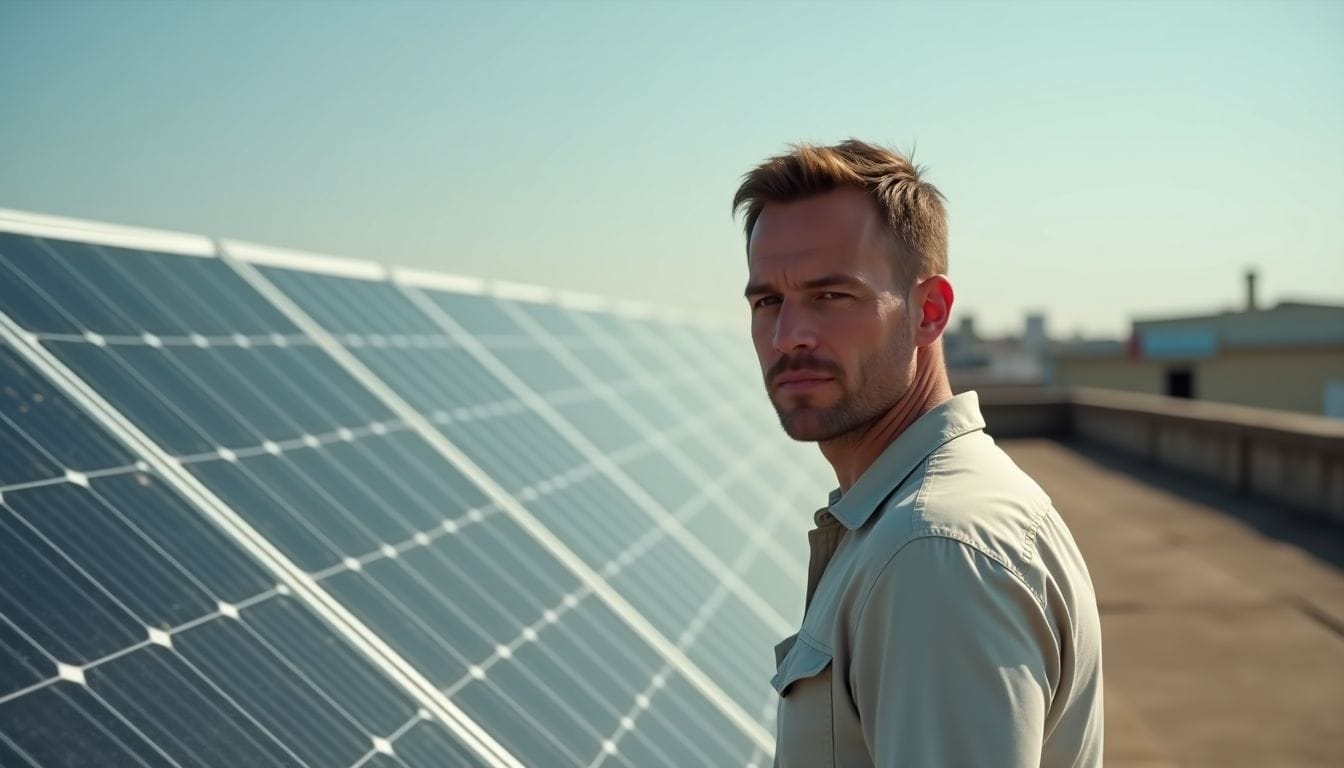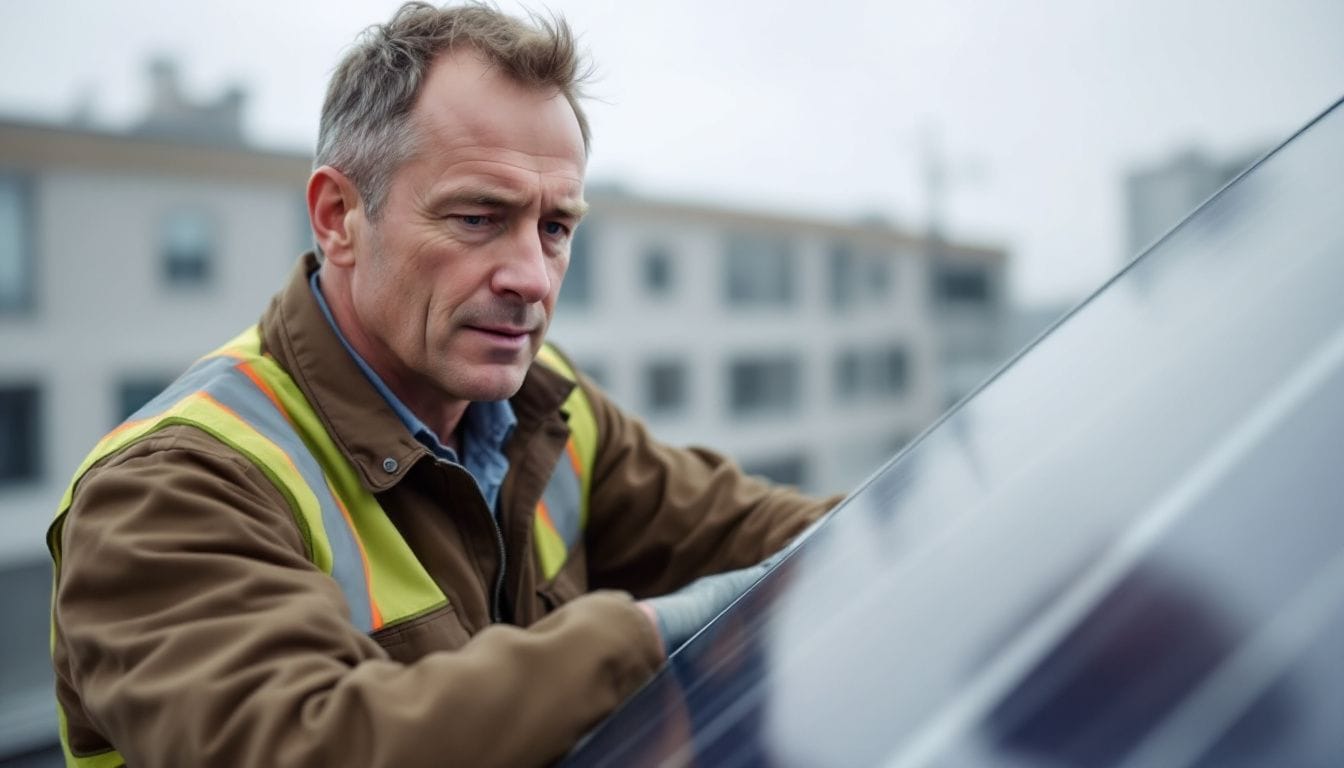How Long Do Commercial Solar Panels Last?
Solar panels are a big deal. Many firms want to know how long they’ll last. It’s a key factor in deciding to go solar. The cost and return on investment hinge on this.
Commercial solar panels often last 25 to 30 years. Some new models may even work for 40 to 50 years. This blog will cover panel life, factors that affect it, and how to make panels last longer.
Ready to learn more about solar panel life?
Key Takeaways
- Commercial solar panels typically last 25 to 30 years, with some new models lasting up to 40 or 50 years.
- Most solar panel makers offer 25-year warranties, promising at least 80% power output after 25 years.
- Panels lose about 0.5% to 0.8% efficiency each year due to wear from sun, heat, and weather.
- Quality materials, good weather, and regular cleaning help solar panels last longer.
- After 30 years, panels may still work but with less power output, leading some owners to replace them.
Average Lifespan of Commercial Solar Panels

Commercial solar panels are built to last. They often work well for 25 to 30 years.
Typical Lifespan Range
Commercial solar panels typically last 25 to 30 years. This lifespan matches most manufacturers’ warranties, giving buyers peace of mind. Modern panels often exceed this range, with some lasting up to 40 or 50 years.
Panel quality has improved greatly over time. Today’s solar technology uses better materials and design. This means panels can work well for longer periods. Many businesses find their solar systems still produce plenty of power after three decades.
The useful life of solar panels is generally considered to be 25 to 30 years after installation. During this time, they continue to generate electricity efficiently. After 30 years, panels may still work but at a reduced output.
Some owners choose to replace them at this point for better performance.
Warranties and Performance Guarantees
Solar panel makers offer strong warranties. Most give 25-year limited power warranties. These promise panels will work at 80% or more of their rated power after 25 years. Some top brands even guarantee 90% output after 25 years.
Performance guarantees back up these long warranties. They ensure panels meet set efficiency levels over time. If a panel falls below the promised output, the maker will fix or replace it.
This protects your investment and gives peace of mind.
Inverter warranties are shorter, lasting 5-15 years. Inverters change DC power from panels to AC power for use. They’re key parts that may need replacing during a system’s life. Extended warranties can cover inverters for the full 25-year panel warranty period.
Factors Affecting Solar Panel Longevity
Solar panels don’t last forever. Their life span depends on many things. Quality materials and good weather help them last longer. Harsh sun and extreme temps can make them wear out faster.
Quality of Materials
Quality matters in solar panels. Top-grade silicon boosts durability and efficiency. Grade A silicon can reach 22% efficiency, a key factor in panel lifespan. PERC technology panels degrade slower, at just 0.5% yearly.
This means they keep working well for longer.
Panel materials affect how they handle stress. Better materials resist cracks and damage. Microcracks can cut power output by 3%. Choosing high-quality panels from the start pays off.
They last longer and produce more power over time.
Environmental Conditions
Environmental conditions play a big role in how long solar panels last. Harsh weather can hurt panels a lot. Too much heat makes panels expand and get brittle. This cuts their life short.
Cold and wet places cause rust on metal parts. Panels in these areas may not work as well after a few years.
Dust and dirt build-up is another issue. It can block sunlight and lower panel output by up to 25%. But panels in mild climates do better. They keep 96% of their power after 20 years.
To help panels last, put them where the weather is not too extreme. Clean them often to remove dust. These steps can add years to panel life.
Solar Panel Degradation Over Time
Solar panels lose power over time. This drop happens due to wear from sun, heat, and weather.
Causes of Degradation
Solar panels face several threats to their longevity. Microcracks in cells can form due to thermal stress or rough handling. These tiny breaks grow over time, cutting power output.
UV rays and heat also play a role, slowly breaking down materials. Harsh weather like hail or heavy snow can cause physical damage.
Environmental factors take their toll too. Dust, dirt, and bird droppings block sunlight, reducing efficiency. In coastal areas, salt air corrodes components. Thermal cycling – daily hot and cold shifts – stresses panel materials.
Light-induced degradation hits new panels, causing a 1-3% drop in the first year. After that, panels typically lose 0.5-0.8% efficiency yearly.
Rate of Efficiency Loss
Commercial solar panels lose efficiency over time. This gradual decline affects their power generation capacity.
- Panels degrade at about 0.8% per year on average
- Premium models show slower loss, around 0.3% annually
- The National Renewable Energy Laboratory reports 0.5-0.8% yearly drops
- Jinko Solar modules decrease by 0.55% each year
- Weather exposure causes tiny cracks in solar cells
- UV rays slowly break down panel materials
- Heat stress can speed up efficiency loss in hot climates
- Dirt and dust buildup blocks sunlight from reaching cells
- Regular cleaning helps maintain panel performance
- Most panels keep 80% or more efficiency after 25-30 years
- Newer tech may slow future degradation rates
Conclusion
Commercial solar panels last 25-30 years on average. Quality materials and proper care extend their life. Regular cleaning and maintenance keep panels working well. Newer models may even last 40-50 years.
Solar technology keeps improving, promising longer-lasting panels. Invest in solar today for decades of clean energy.

